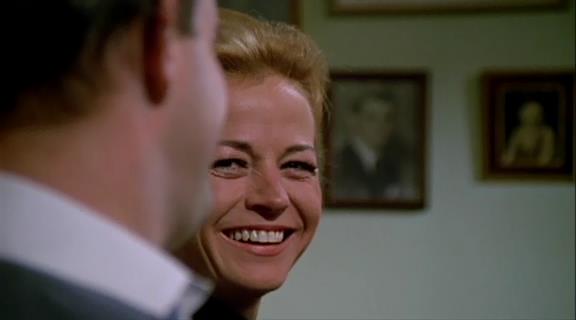Joe

New York harmonies, Greenwich Village,
Astoria, Madison Avenue, “up Route 9”.
Things fly apart, it comes to a decisive point, killing kids (cf.
McLaglen’s Shenandoah).
Variety, “pretty, it’s not. By concentrating on the extremist fringes of the various social elements involved, Norman Wexler’s script makes audience identification well-nigh impossible and at the same time abstracts the questions in a way that gives the pic real importance.” Film4, “bleak portrait of America shows a dream turned sour and a country at odds with itself.” TV Guide, “it touched a lot of nerves at the time”. Halliwell’s Film Guide, “opportunistic melodrama”, citing Penelope Gilliatt, “a bad film”.
“D’ya ever get
the feeling that—everything you do—your whole life, is one big crock o’ shit?”
“Yeah.” Cf. Dassin’s The Rehearsal.
From Easy
Rider (dir. Dennis Hopper) to The
Last Detail (dir. Hal Ashby). The model of composition is evidently
Truffaut’s Tirez sur le pianiste at some distance, cf. Hecht & MacArthur’s
Soak the Rich.
Foreplay
Three short films joined by “Professor Corey on Sex”, each with
a different writer and director (Professor Irwin Corey, the great academic,
explains everything), the last most beautiful of all.
“Norman and the Polish Doll”
Purchased at
F.A.O. Schwarz, life-size, returned as unsatisfactory and with very good reason
(Dan Greenburg’s masterful Polish joke).
“Vortex”
Bruce Jay
Friedman on hacks (the muse is an Italian named Roberto).
“Inaugural Ball”
The President and
Don Pasquale, who sleeps with the Chief Justice in drag.
Capra’s State of the Union is called into play,
the writer is David Odell.
“What’d I tell
ya, we got a lame fuck President!”
Signed by
Avildsen (following Rosenblum, McCarty and Malmuth).
Janet Maslin saw it at the Thalia only in 1981 (as The President’s Wife) and was incensed,
“smutty... languished in deserved obscurity... dopey... misogyny... idiocy” (New York Times).
Primarily a feast
of writers, then of actors, also directors.
The Formula
The title refers to the Genesis project in World War II,
undertaking the manufacture of synthetic fuels from coal, under the supervision
of Goering.
The question is
not whether the glass is half-full or half-empty, but whether the frog in the
swimming pool is half-dead from chlorine.
Beautiful views of
the mountains from Santa Anita and a Los Angeles sunset from Westwood.
The Power of One
It will be probably be seen that the dominant stylistic aspect
is the reaction shot, to constantly establish that the film exists in the form
of the protagonist’s impressions, from childhood to early manhood. This gives
the stylistic unity from first to last needed for compositional development on
the minute scale required, and in that sense it serves a constructional
purpose. The Power of One, despite the end title proposing a bland union
of absolute conviction, is not expansive but interior in its meaning. This is a
paradox of art, the details are realistic and rapidly
subsumed.
Two sequences early on show the material that is dealt with and Avildsen’s skill. The prelude to these sequences is a most
charming gag, after inducing in the boy by fearsome gestures and intense
palaver the vision of an African elephant (filmed after the manner of Smight’s The
Illustrated Man), the witch doctor in leopard skin and cowrie
shells is met by his wife in housedress and headscarf, and the two take the boy
by the hands to walk him home, chatting like an old married couple.
The first sequence follows this. Schoolchums
surprise the boy with a rooster, which he feeds out of his hand. War is
declared, Nazi schoolboys hold a candlelight rally clandestinely. The boy’s
rooster is hung by its feet and killed with a slingshot not of the American
variety but the Biblical one. The boy protests, is hung by his heels and struck
likewise, on the forehead.
The second sequence cranes down on a small Dutch town with brick
church and donkey cart, and doesn’t miss the delicacy of the curbstones. The boy is shown nature in Africa, learns to draw it and play music and
grow plants. His Dutch or rather German uncle (Armin
Mueller-Stahl) is interned for the duration, along with his grand piano and
plants, and in the camp the boy learns how to box from a trainer (Morgan
Freeman).
There’s something beyond the pictorial aspect in all this,
though that is remarkable enough, and beyond the symbolic as well. It’s
visionary, at least in the sense that it speaks a surprisingly intimate
language with common terms.
It’s not surprising that the director of The Formula
should have acquired even more skill over time, but the sheer agility of these
two sequences, which are not long (the first is very brief), achieves more than
compression. By the nature of the stylistic construction, they fix images in
the mind consciously, and beyond this do not call attention to the fact.
One other scene takes place in a big office with a mural of
covered wagons and Dutchwomen watching black men being hanged. That particular
small portion of the mural (which runs around the room) is set directly over
the desk where the great man sits, but behind him on a console is a photograph
of his wife in a silver frame, and this tacitly is the intimate level of his
daily operations. Avildsen sets the scene with this little symphonic treatment
and lets it go without further comment, except for the obligatory reaction shot
of the young man’s face.